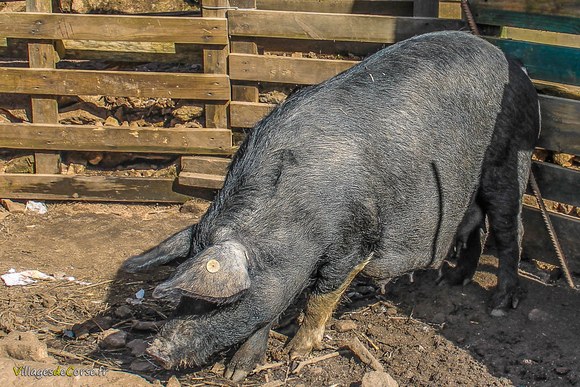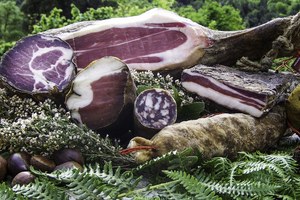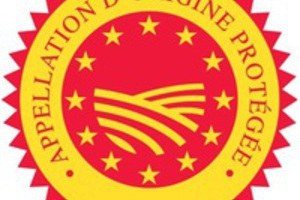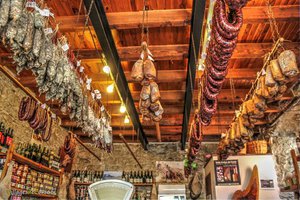- Activities
- Gastronomy
- Corsican charcuterie
- Porcu nustrale pig
The Corsican black pig - Porcu Nustrale
Recognition of the Corsican pig breed in 2006

The Corsican pig - closely related to the wild boar, with cross-breeding not uncommon - was officially recognized as a pig breed in its own right just over 10 years ago. Rooted on the island for centuries through traditional breeding, the Corsican pig has been threatened by industrial breeding and mixing with other duroc, large white or landrace pigs.
At the end of the 90s, when there were only a hundred or so identified breeding pigs left, breeders mobilized against this programmed disappearance and began to register their animals by genealogy, managing matings and taking care to avoid inbreeding, with a view to gaining recognition for the island breed. Ten years later, in early 2006, this work led to the designation of Porcu Nustrale as a Corsican pig breed. The breed is registered with the Ligéral (Livres Généalogiques Collectifs des Races Locales de Porcs) - an organization approved by the French Ministry of Agriculture - joining 5 other pig breeds: Pie Noir du Pays Basque, Bayeux, Gascon, Cul Noir Limousin, Blanc de l'Ouest and now the Porcu Nustrale. A first step in the recognition of the island pig breed, whose preservation depends on constant attention, as their numbers painfully exceed a thousand individuals.
Physical characteristics of the Corsican pig
The Corsican pig is a little smaller than its mainland congeners, measuring 60 to 65 cm in height and 1.15 m in length, and weighing up to 160 to 200 kg for a sow, and 220 kg for a boar. It wears a more or less dark black coat - porcu neru - with a short coat and rounded back, reminiscent of the Gascon pig. The head is elongated all the way to the snout, with horizontally erect ears that may hang over the eyes, which are hard to see. The tail is medium-sized, forming a tuft. Accustomed to living freely in groups in wooded areas that avoid scrubland, the Nustrale tolerates human presence, which leaves it unperturbed as long as there is no interaction. A safe distance must always be maintained in the absence of the breeder.
The noisy nature of the animal in many circumstances can also come as a surprise, especially when the animals are in their pens.
Diet
Pigs on ancestral farms were mainly fed in the mountains and on leftovers. As Corsica remains a predominantly rural region, pigs enjoy a certain degree of freedom and continue to feed on acorns or chestnuts in autumn, as well as on all kinds of vegetation and roots in the pastures and mountain pastures. Cereals such as barley, wheat, corn and oats can be added to this natural diet by the breeders. Paddocks are reduced to earth, reflecting the suidae's omnivorous diet. The pig will not leave the slightest shoot without pulling it up, making it the best brushcutter of all.
Geographical distribution
Porcu nustrale pig farms are found mainly in southern Corsica (with the exception of the extreme south and east), particularly in the western part. In Haute-Corse, they are also found in Castagniccia, a region of chestnut groves and dense forest ideal for breeding. Most other farms also have Corsican pigs, but to a lesser extent.



